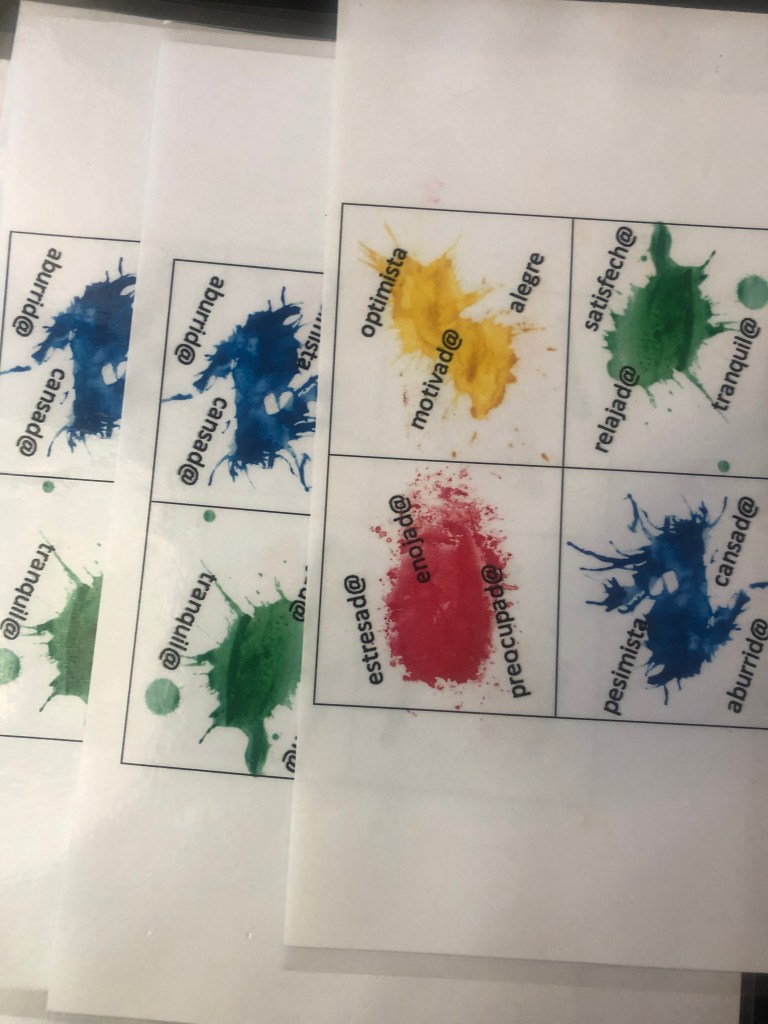The Mood Meter Activity is a Perfect Addition to Your Classroom Routine!

¿Cómo estás?
Really, how are you? Does your mood affect how willing you are to learn? Or to engage in a particular lesson? Do you think that acknowledging feelings can help you make a shift? These are the questions explored by the Yale Center for Emotional Intelligence, and their creation of the Mood Meter has provided students with specific vocabulary for identifying their emotions, and possibly, making a shift (from red/blue to yellow/green). We have been using the Mood Meter in our school for the past three years. It started with an initiative to inject more social emotional awareness into the ethos of the school, flowing through and connecting the veins of classroom practices. With this systemwide shift to teach the whole child, the Mood Meter protocol became routinized in our school, and naturalized into our educational discourse.
Descriptive Language For Identifying Nuanced Emotions
As pictured above, the Mood Meter is a square divided into four quadrants — red, blue, green, and yellow — each representing a different set of feelings. Different feelings are grouped together on the Mood Meter based on their pleasantness and energy level. Classroom.couture, a Spanish Teacher and Fashion Guru on Instagram, has enabled us as language educators to access this matrix of emotions in Spanish class, while honing a very useful communicative tool (Check out her blog here, and discover productivity hacks, fashion advice, and how to stay healthy and vibrant). Find out how I use her adaptation of the Mood Meter in my classroom, and you’ll be in the MOOD to use it as well! Click here to link to the resource created by Classroom.couture.
This Is How We Roll
We start class everyday with the Mood Meter! I printed out the MM Dashboard, and laminated the cards to make them durable. After the first few introductory rounds, students grab a card as they file into the room, or I have a student distribute them (it depends on the class). After everyone is seated, check-in begins. Since we’ve been employing this practice daily Novice level 1, and it has proven to be one of the most effective, vocabulary- acquiring bellringers! IT SETS THE TONE FOR THE CLASS. Students look forward to the Mood Meter activity because they get to share how they’re feeling while expanding their vocabulary. How do I introduce to my class? Check out my introduction as well as my sustainability routines below!

Adapted to Spanish by @Classroom.couture
Check out my Youtube video here! I will be providing demonstrations through out the first couple of weeks as well.

https://www.youtube.com/watch?v=S9zTe6XvSNk
Starting From Scratch
Prior to the implementing the Mood Meter, on the first day of school, I’d have three emojis projected on the screen. Each one with an easily identificable expression. I would ask students how they were feeling, and they could point to the emoji, or try to say it. Now, with this new Mood Meter tool, I can take that a step further. The first thing I do is have students observed the quadrants of the MM. Then, I commence classroom discourse pointing out the specifics of the tool. I provide examples below:
“Hay cuatro partes aquí, clase y hay cuatro colores. Aquí tenemos rojo, azul, amarillo y verde”. ¿Cuántos colores hay? ¿Hay dos colores (I do this holding up two fingers)? ¿Hay tres colores? ¿Hay cinco? ¿Hay diez?
I capitalize on this activity to integrate more input, and have them make associations, even on the first day! This can be taken a step further. To introduce them to colors, I repeat the four colors of the quadrants, and then asking them how to say them in English. You can easily use one of the two approaches below (or a novel one!).
- ¿ Cómo se dice “rojo” en inglés? ¿Cómo se dice “amarillo” en inglés, etc?
- ¿Cómo se dice “rojo” en inglés? Red or White?
This activity can be further comprehended by students if you write the colors on the board. or use a poster with where to you can point. You may not have to, but I also do this for my students who have processing issues, and may need struggle with auditory/visual learning in this sense.
Turn it into a lesson!
I proceed to go around class to see who has those colors on. I’ll point out that someone has amarillo, then rojo, etc. After doing that for a few minutes, I will model commands, and direct students to stand up when they hear the colors. See my examples below:
“Levántense [todos] los estudiantes con el color amarillo” (pointing to yellow)
“Levántense los estudiantes con el color azul”
“Levántense los estudiantes con el color rojo”
“Levántense los estudiantes con el color verde”
There will be students whose colors don’t match; which in the CI World equates to an opportunity to circle (ask questions) using those colors not representative in the Dashboard palette. At this juncture, I would model the other colors; “Tú no tienes el color rojo, tú no tienes el color amarillo, etc. Tienes el color blanco. Y tú, tú tienes el color morado.” You could use this activity for front-loading the other colors.
Turn It Up!
Okay, so if you’re really “feeling” this activity, you can do a Speed-dating activity whereby students write the names of their new classmates and check off the color they have one. Download the activity here, and use it in class!
Colors and Quadrants
The next step, which does not have to be used in the same day, is to assign emotions to the colors. You could model, “furioso” with the color red, or “relajado” with the color green. This lays the groundwork making the Mood Meter Medley! Next, we play a guessing game. Students love INQUIRY-BASED activities. They love guessing so I try not to rob them of this opportunity.
Make It a Fun Guessing Game!
Have a MM Dashboard in hand. This is the when you start looking at the vocabulary and making those “incidental” corrections. One of the things that my colleague Classroom.couture did in creating the Spanish version is to make sure most of the words were cognates. THIS IS SO HELPFUL! It is an INCIDENTAL VOCABULARY WHEN THROUGH AND THROUGH. How the paper in front of the class, and/or project it so you can now discuss the words (she also does a digital version with her students, so she can gauge how the class is doing).
Distribute mini whiteboards to the students (or they can use their notebooks) and have them guess the word as you model it.
––Point to the color, so that their eyes are not roaming around the board. They can zero-in on one quadrant of the board. This also lowers the affective filter.
––Proceed to say the word with the appropriate facial expression or gesture, and let them write down the guesses in English.
Other options: You can give then three options in English for every word. For example: The word “Enojado” could be paired with the appropriate facial expression, emoji, bitmoji and/or picture to provide a clear connection.
Word Up!
With level 1 Novice-mid 1 students, we focus only on the words first! After the variety of activities listed above, we can now start our check- in. At this point, we do one word check-ins, and I don’t usually instruct on gender-noun agreement during the first few weeks. I allow them to let the words soak-in, and then later, I give examples of gender nouns. This worked really well last year, in fact, mid year, they were correcting each other.
Here’s how this looks in my class:
- Students are seated with their Mood Meter in hand.
- Teacher asks: ¿Cómo estás? or ¿Cómo te sientes? I prefer the former because it’s less complicated.
- Each student who wants to share (I make it optional) share one word.
Speed Dating With Rejoinders
Once we are well on our way with using this feeling-processing tool, I’ll have students take on the role of asking each other how they are doing. Now, this is where it gets fun! Students will have three rejoinders on the board. They get the choose their own reaction to what was said. Check out the pictures below to get an idea!

This way, students learn how to be empathatic in the target language.

As students get comfortable with using the Mood Meter, it becomes second nature to them. As we processed through the year, the structures take on a more complex nature, and students are able to expand how they feel, and what they feel. The best part is that I don’t necessarily have to “teach” the vocabulary. I do provide them with a Quizlet list (why, not?) in case they’ll like to review, but we do this everyday in class, so expressing their feelings become more automatic and authentic. Are you in the MOOD for this activity? Download your activity today, and make sure you check back on @Classroom.couture Teacherspayteachers store, Instagram Linktree, and or Website for more extended use of the Mood Meter!
Additional Sources:




